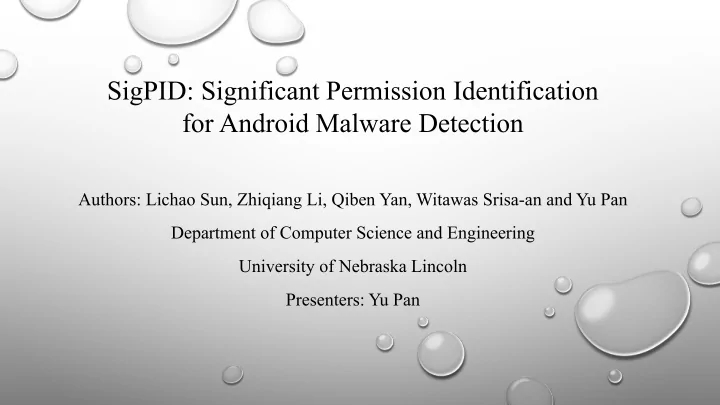

SigPID: Significant Permission Identification for Android Malware Detection Authors: Lichao Sun, Zhiqiang Li, Qiben Yan, Witawas Srisa-an and Yu Pan Department of Computer Science and Engineering University of Nebraska Lincoln Presenters: Yu Pan
Android OS • Android is the most popular operating system for smart-mobile devices • Android is also widely used in other mobile platforms, such as tablets, smart tvs, and smartwatches, etc. 2
Growth of Android Malware • Android allows to install applications from uncertified third party stores There is a need to create an effective and efficient • 97% of all mobile malicious applications malware detection system to cope with this rapid growth target Android of malicious apps. • A new Android malware appears every 11 seconds 3
System Overview 2 Support Vector Machines permission matrix (an app constructs a vector) benign apps 1 5 7 3 Decision Tree Training & Testing Multi-Level Data Pruning 6 Malware Detection Results malicious apps 4 Results Malware Detection System new permission matrix 4 (less features after pruning) Building Detection System Data Pre-Processing
Introducing SIGPID • Multi-Level Data Pruning (MLDP) • Malware Detection using Significant Permission • Advanced MLDP with Fusion of Multiple Lists and X-value 5
Multi-Level Data Pruning (MLDP) • Motivation: 135 permissions + huge number of applications = long processing time • Three levels of data pruning 1 2 Permission Ranking with Negative Rate Support Based Permission Ranking Permission Mining with Association Rules 6
Balance Benign and Malicious Matrixes • Two matrixes: • Matrix of original malware: M • Matrix of original benign apps: B • Permission support formalization: 7
Permission Ranking with Negative Rate (PRNR) • No need to consider all 135 permissions • Extract significant permissions: • Highly risky permission requested by malware • Rarely touched permission by malware • Remove permissions equally used by benign and malicious applications 8
Permission Ranking with Negative Rate (PRNR) • R(P i ) = [-1,1] • -1 means non-risky permission • 1 means risky permission • 0 means lowest impact • -1 to 0 • 0 to 1 • Near 0 9
Permission Incremental System (PIS) • Two sorted permission lists based on PRNR • Choose the top permissions in benign and malware permission lists and evaluate malware detection • Choose top three permissions in both lists and evaluate malware detection • Repeat until f-measure becomes stable • Remove 40 insignificant permissions from the total of 135 permissions Remaining Permission : 135 – 40 = 95 10
Support Based Permission Ranking (SPR) • Prune permissions with low impact • Two policies • Use PIS to find the least number of permissions • Set a very small threshold of support • Remove 70 more permissions Remaining Permission: 135 – 40- 70 = 25 11
Permission Mining with Association Rules (PMAR) • Some permissions are always used together • We can use the one with higher support to represent both • Use Apriori with 95% minimum confidence and 3% minimum support • Remove 3 additional permissions Remaining Permission: 135 – 40 - 70 = 25 12
Evaluation • Data Set • MLDP Effectiveness • Malware Detection Performance with Different Machine Learning Algorithms • Comparison with Other Approaches 13
Evaluation Criterion prediction malicious benign • Precision malicious TP FN actual benign FP TN • Recall • F-Measure 200 apps (100 malicious apps + 100 benign apps) prediction malicious benign malicious 85 15 actual benign 5 95 Precision = TP/(TP+FP)=94.4% Recall = TP/(TP+FN)=85% FM = 2*Precision*Recall/(Precision+Recall)= 89.7% 14
Data Set • 1,661 and 5,494 malicious applications • 310,926 benign applications • Extract permission information from the Android Manifest file of each app • One vector represent an app with 1s and 0s, where 1 represents required permission and 0 otherwise 15
Multi-level Data Pruning Effectiveness • Permission ranking with negative rate (PRNR) effectiveness • Support Based Permission Ranking(SPR) effectiveness • Permission mining with association rules (PMAR) effectiveness 16
Multi-level Data Pruning Effectiveness Number of Status Precision Recall(TPR) FPR F-measure Accuracy Permissions 135 Original 98.81% 83.73% 1.01% 90.65% 91.36% 95 PRNR 96.39% 85.78% 3.22% 90.77% 91.28% 25 PRNR+PMAR 90.64% 91.77% 9.56% 91.17% 91.10% 22 PRNR+PMAR+SPR 91.55% 91.22% 8.54% 91.34% 91.34% 17
Malware Detection using Significant Permissions • Implement 67 machine learning algorithms • Compare 22 permissions with 135 permissions 18
Performance of Machine Learning Algorithms # of Permissions 22 40 135 Name of Algorithm Time(Seconds) Time More Time Time More Time RandomCommittee 1.376 2.078 51.02% 7.995 481.03% RotationForest 47.303 71.887 51.97% 236.944 400.91% FT 0.731 2.14 192.75% 24.55 3258.41% PART 16.673 24.645 47.81% 104.74 528.20% RandomForest 14.028 20.045 42.89% 59.991 327.65% SVM 2.4722 2.7604 11.66% 3.6773 48.75% 19
Optimal ML Algorithms For SigPID and Android Dangerous Permissions #of Permissions Best ML Precision Recall(TPR) FPR F-measure Accuracy SigPID (24) FT 97.54% 93.62% 2.36% 95.54% 95.63% Android (22) Random Forest 98.61% 90.35% 1.27% 94.30% 94.54% 20
Detection Performance using Unknown Real-World Malware RandomForest PART FT RotationForest RandomCommittee 83.0% 84.0% 85.0% 86.0% 87.0% 88.0% 89.0% 90.0% 91.0% 92.0% Android MLDP_22 21
Comparison with other approaches Method Recall SigPID with FT 93.62 SigPID with SVMs 91.22 Mutual Information 86.4 Drebin 93.9 AV1 96.41 AV2 93.71 AV3 84.66 AV4 84.54 AV5 78.38 AV6 64.16 AV7 48.5 AV8 48.34 22 AV9 9.84 AV10 3.99
Future Work • Enlarge dataset for malware and collect more features of the original dataset • Develop a new machine learning algorithm • Use additional information, such as that obtained through static program structure information (e.g., Static call graphs and calling context) and runtime information (e.g., Dynamic call graphs) to further classify behavior and pinpoint locations of malicious code 23
Conclusion • We have developed a malware detection system based on permission • We are able to only consider a fraction of permissions to provide effective malware detection • Our approach performs as well as or better than techniques that consider more permissions or all permissions • By using significant permissions, we can improve performance a lot 24
Recommend
More recommend